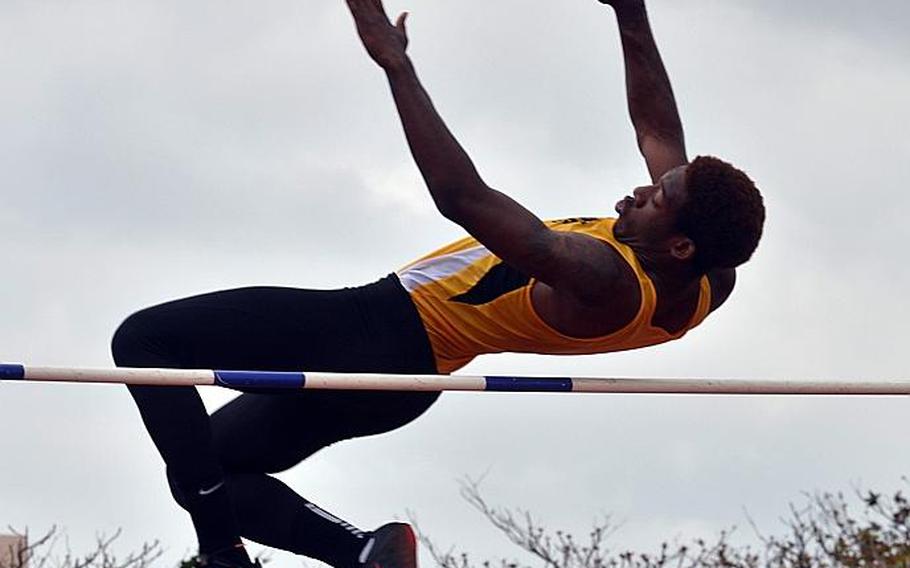
Kadena's Preston Harris clears the high jump bar during an Okinawa track and field meet at Mihama, Okinawa in April. Harris, who has qualified for the Far East Track and Field Meet, won with a jump of 6 feet, 2 inches. (Dave Ornauer/Stars and Stripes)
TORII STATION, Okinawa – When it comes to the Far East Track and Field Meet, everyone can agree on at least two things: It’ll be May 19-21 and held at Yokota Air Base.
After that, ideas start to diverge.
Since the meet began in 2010, there’s been an ongoing discussion about how many athletes should qualify for each event, how many from each school and how qualifying should work in general.
The largest issue this season appears to be the qualifying date.
Athletes and coaches feel April 27 is too early, with a potential of three weekends of meets after that losing much of their value. Athletes’ incentive to continually improve might suffer as a result.
Administrators say qualifiers have to be determined as early as possible in order to buy airline tickets cheaply and other logistical concerns.
“It all comes down to the plane tickets,” meet director Dan Galvin said, citing DODDS’ ticketing procedures. “If they want these events at all, they have to do it within limited budgets. If they can’t afford to buy (tickets) later, they have to do qualifying early.”
But that hurts the quality of meets such as Saturday’s Kanto Plain and DODDS Korea finals, which come after the deadline.
“With the training people do in the regular season, they plan to peak right around districts and Far East because they are so close to each other,” said two-time Far East cross-country champion Andrew Kilkenny of Kadena. Okinawa’s district finals were last Saturday.
Coaches try to see both sides of the issue.
“I’m not in the situation (Athletic Coordinator Don Hobbs) is in. Are we even going to have a Far East? Do we have enough money to do it?” Humphreys coach Mitch Moellendick said. “Can it be done better or not be done better? I know that Don is doing his best get as many participants as possible.”
To do that, Hobbs solicited quotes from six local travel agencies in late April. He sought fares for six flights, bunching as many teams as he could to hold down costs.
“And we always go with the lowest bid,” Hobbs said, adding that if the qualifying deadline was pushed to May 3 or 10, “we wouldn’t necessarily get the low bid. The later you wait, the higher the bid is.”
DODDS-Pacific won’t provide specific dollar figures for its sports programs, but Hobbs and others have said there is less money this year than last year.
Tickets cannot be bought in blocks with names filled in later for teams traveling internationally such as Guam or Seoul American, Hobbs said. And names can’t be substituted later either, he said.
So an athlete who meets a qualifying time or mark after the deadline is out of luck.
“I’ve gotten a lot of e-mails presenting some heartbreaking arguments why we should let one more kid in who’s just off the qualifying mark,” Galvin said.
The first Far East meet in 2010 saw each school able to field five boys and five girls, with no qualifying times or marks. That’s something Moellendick, who coached Zama at the time, said he was “adamantly” against and doesn’t want to see happen again.
“Let’s have them qualify, let’s have it mean something, you want to bring the best of the best, give them an incentive to want to work hard … instead of saying it’s another free trip on the government’s nickel,” he said. “They have a goal to meet and not just say they went.”
“Do we want people running Pacific or Far East record times in the 800 and have people finish 30 or 40 seconds behind them?” Hobbs said.
Some have suggested moving up the district meets to meet the qualifying marks, then holding all-comers meets – in which military members could also participate – decathlon weekends or meets featuring only relay races.
“Why not?” Hobbs said.
“That’s an interesting thought,” Galvin said. “It would be interesting to see what they could do to fill in” after qualifying.
Most of those surveyed say they expect to see more changes in the track schedule in the coming years.
“If it’s five years ago, we wouldn’t have Far East track,” Kubasaki coach Jon Fick said. “It’s in its infancy, how people qualify, how the meet should be run, ticketing; it’s a new event and we’re still trying to figure it out.”